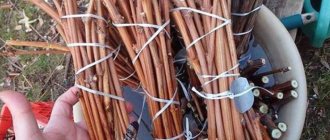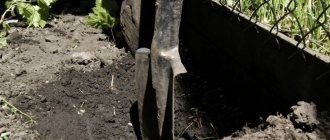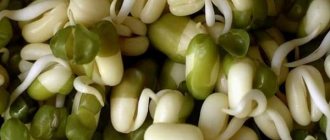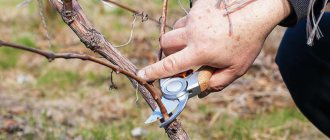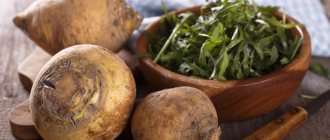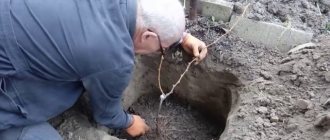It’s easy to grow a grape seedling yourself; you don’t need any special conditions or equipment for this. Even a beginning winegrower can fully provide himself with planting material during the warm season without any financial investment.
Growing seedlings with your own hands is convenient and profitable in all respects:
- Varietal chibouks cost a mere trifle compared to ready-made planting material.
- Rooting cuttings allows you to obtain a viable seedling in early summer, while cuttings in open ground only in September. In fact, in 1 season the cutting manages to go through a 2-year cycle and begins to bear fruit 1 season earlier.
- The winegrower is not tied to seasonal supplies of planting material to the market - he has the opportunity to independently and completely free of charge grow any number of seedlings of excellent quality.
- After autumn pruning of the vines, you can get so many shanks that they are enough even for the production of seedlings on an industrial scale.
The useful ability to grow planting material with your own hands will always be useful for repairing, expanding or starting a new vineyard.
A little theory that an ordinary summer resident cannot do without
All the rules for cutting vines for harvesting chibouks have a scientific basis. Without a clear understanding of the structure of the vine, cutting cuttings turns into a set of sequential monotonous actions to fulfill strict and completely incomprehensible requirements.
All operations for harvesting grape cuttings will seem simple and understandable if you understand the structure of the vine segment. Nodes and internodes - the entire grape vine consists of them.
The easiest way is with internodes . Their main purpose: transit of nutrients and water, by analogy with human blood vessels. The outer cover (bark) protects the wood from damage and moisture loss. Under the bark is the cambium , a thin layer of tissue responsible for regeneration processes. If we continue to draw analogies with the human body, cambium is an analogue of stem cells, which, under certain conditions, give rise to any organ. In the case of grape propagation, it is the cambium cells that develop into the root system of the seedling.
For the successful transformation of cambial tissues, a supply of nutrients and moisture is required. in the core , which support vital processes during winter storage and feed growth processes during rooting.
The second mandatory component responsible for metabolic processes is water. The distribution of water reserves in the vine (and the cut cuttings) depends on the nodes, which can be simply described as a regular membrane.
There are 2 types of nodes (see picture):
- The core channel is blocked to a large extent - the outflow of nutrients is significantly slowed down. Most nodes on vines are of this type. They are responsible for the outflow of nutrients at the end of the season from the leaves to the roots and sleeves.
- The internode forms an almost blind membrane, which maximally retains the flow of water and nutrients. Type 2 knots on the vine are easy to find - just find a knot with a tendril .
The most promising units for preparing pipes can be easily determined by eye:
- evaluate the difference in the thickness of the vine and the diameter of the node and select a section of the vine according to the principle “the thicker the node, the stronger the growth bud”;
- For the lower (heel, root) part of the cutting, select nodes with remnants of a tendril, i.e., with a developed internal partition.
After such a “lyrical digression,” there should be much fewer questions about the rules for cutting cuttings.
About the readiness of seedlings for transplanting into the ground
When rooting in water, it is not difficult to understand that the chibouks are ready for transplantation. The roots are visible to the naked eye. When their length reaches 3 cm, they need to be transplanted into the ground. They will be well received.
When rooting in the soil, it is impossible to examine the root system. Then, 20 days after the start of the process, the plant is slightly twitched. If resistance is felt, it means roots have formed. Now reduce watering and wait for foliage to appear.
Plants can be left in the substrate until transplanted into open ground. Sprouted plants are planted in the first half of May, when the weather is finally warm.
Comparison of grape cutting methods: choose simple and reliable
Gardeners of the Central region are accustomed to autumn planting, which invariably shows good results in the survival of fruit seedlings in the month of September. Currant cuttings are traditionally planted in greenhouse “schools” in late autumn in order to obtain a strong young bush during the season.
Unfortunately, the benefits of autumn rooting do not apply to grape seedlings. The result does not live up to expectations - the yield suitable for further cultivation is unpredictable (no more than 20%).
Reason 1
The cutting must go through a period of rest - the tissues responsible for the development of roots and fruit vines must ripen within 3-4 months. It only seems that the cuttings “sleep” in winter. In fact, unhurried metabolic processes are taking place: the rudiments of all plant organs are developing. Without this phase it is impossible to obtain a strong seedling.
You can try to hurry up nature and root green grape cuttings in the summer. Be prepared to spray daily, monitor temperature and light conditions. The slightest miscalculation and violation of the regime leads to rot or drying of plants. Even if everything worked out, the cutting took root and began to grow, it is strictly forbidden to plant it in open ground.
Reason 2
The vines of an adult bush easily tolerate frosts of -15...20 degrees (some varieties - up to 35). The root system dies at -10...12 degrees. Rooted cuttings are planted to a depth of 20...30 cm. The young seedling is doomed - its roots freeze out, the plant will not survive until spring.
Interesting fact
Winegrowers of the southern regions, despite the relatively warm autumn and winter, prefer to root chibuki in the spring at home in cups or a little later - in shkolkas. The experience of many generations confirms that such chibouks easily form roots and shoots, and in the summer they are completely ready for planting in a permanent place.
The only requirement: high-quality cuttings are needed - cut on time, properly stored and prepared for rooting. Autumn planting of cuttings in a schoolhouse does not give guaranteed results even in the Southern region
Planting grape cuttings in February. Early or just right?
No one will give a clear answer to this question. Grape cuttings are rooted from January to April, it all depends on the conditions of the winegrower and the region. In this matter, you just need to analyze your desires and capabilities. For example, I live in the Urals in the Republic of Bashkortostan, I have a greenhouse in which I can keep my seedlings during return frosts, I plant the greenhouse with tomatoes on the May holidays, most often on May 09-10. I will start from this date. If I start rooting grape cuttings in mid-March, then in early April they can be planted in cups, I will keep them on the windowsill and under lamps for a month, by May the root system will occupy the entire volume of the cup, in the greenhouse I will transplant the seedlings into a larger one container and will keep the grapes in the greenhouse until June. And suppose you live in the south and can plant cuttings earlier, which means we start rooting earlier. I know several winegrowers who plant cuttings in February and they also have excellent results. Or you don’t have greenhouses or hotbeds, in which case you won’t be able to transfer the grapes to the site early, and return frosts are simply destructive for young shoots, so root them not in mid-March, but in early April.
Now about planting cuttings in February. The first question is - do you want to plant it already or put the cuttings to germination? If you plant, it means you started germinating the chibouks back in January, by February they have taken root and you plant them in cups. My personal opinion: February is too early; even in the south, spring return frosts cannot be avoided. It's good if you have one or two cuttings and live in the south. You can plant them in February, transplant them into larger containers in March, then transfer them to a greenhouse in April and grow them there in large containers until the return frosts pass and the cuttings can be transferred to open ground. And if there are a lot of cuttings and by March they no longer need cups, but large pots. Do you have the opportunity to place all the seedlings in the apartment?
Regarding the regions of the Moscow region, the Urals and Siberia, I can say with confidence that it is definitely not worth planting cuttings in February. We plant in April, and place the chibuka for rooting in mid-March.
Harvesting cuttings
To cut cuttings, you need to prepare a sharpened pruner.
In the case of harvesting chibouks from bushes of different varieties, be sure to prepare waterproof tags in advance.
When to take cuttings
Grape chubuks are harvested only after the vines have ripened: late in the fall - during the period from leaf fall to frost. By this time, the cuttings have accumulated the maximum amount of winter reserves: photosynthesis products, various sugars.
Geographically, the timing of autumn pruning varies greatly. In the Central region this may be the end of October, in the south - November or even the first days of December.
It is much easier to navigate not by calendar dates, but by weather signs that exactly correspond to the biorhythms of plants.
Helpful advice
It is better to be late with pruning grapes than to rush and trim the bushes too early.
On time - at the first signs of winter:
- steady weather with night frosts;
- daytime temperatures are just above zero degrees;
- thin ice in the morning along the edge of the reservoir, etc.
For pruning vines and harvesting shanks, you should choose a dry, clear day.
How to properly cut vines into cuttings
Even in the summer, the best bushes for propagation should be noted: in terms of yield, presentation of the bunch, size and taste of the berries. It is best to harvest the stems in parallel with pruning, immediately setting aside promising sections of the vine separately.
Unripe tops are cut off immediately.
- A mature vine is easy to determine literally by touch : in addition to the characteristic crunching sound when bending, the mature area seems warm compared to the cool, unripe top of the vine.
- For cuttings, vines from 8 to 12 mm in diameter are suitable : those that are too thin take root worse and produce weak, sickly seedlings; thick “fatty” shoots are unsuitable for another reason: their underdeveloped “eyes” practically do not form fruitful branches.
- For the lower (heel) part of the cutting, choose nodes with a tendril - such cuttings take root much better.
The lower 1/3 of the vine is considered the best for cutting pipes. This area always has time to ripen well and contains the maximum amount of nutrients. Ideally, it is advisable to put this entire segment for storage.
On a large farm with a large vineyard, it is justified to leave such long cuttings for winter storage. They are buried in a trench. At home, especially in a city apartment, you have to shorten the vine sections to a reasonable size :
3-4 buds + at least 1/2 the length of the internode.
Even when cutting 2 varieties of grapes, the cuttings should be labeled. The shade of the bark can change during storage, and all sorts of “memory nodules” after 3-4 months only cause bewilderment.
Preparing the vine for cuttings
Germinated cuttings for growing grapes are also called chibouks. For them, green or woody vine is used. Cuttings from green vines are prepared in early spring, before the plant juices begin to flow. The time for harvesting lignified varieties is autumn.
The cutting process is considered labor-intensive, but worthwhile.
Procurement time
Cuttings, lignified and green, are harvested at different times.
Green cuttings
Collection is carried out in spring (early summer). The weather should preferably be cloudy. Spring chibouks take root better.
Lignified cuttings
Planting material is prepared in the fall, during the period of pruning the grapevine. It is important to carry out the procedure before the onset of frost. At the end of autumn (beginning of winter) the vine contains maximum nutrients.
The advantages of using lignified material are explained, among other things, by a shorter harvesting and storage period and a probability of rooting of about 100%. Harvesting such cuttings begins 15 days after the bulk of the grape leaves fall off.
How to Determine the Suitable Vine
For cuttings, grape bushes with the best taste and high yield are selected. The vine should be brown, 8-12 mm thick, with 10 cm internodes. It is important to exclude the presence of dark spots, other damage and signs of disease.
It is better to use vines from healthy bushes of varieties that bear fruit in your region. It must be mature, with healthy kidneys.
Proper cutting of cuttings
Properly cut cuttings will produce good quality planting material.
Green (spring) options
The middle and lower parts of the shoot are optimal for rooting. The upper parts are susceptible to rotting, so it is not recommended to use them.
Rules for cutting spring vines:
- the cutting must have 2 leaves or more;
- the bottom sheet is removed;
- half of the top leaf plate is removed;
- oblique cut from below (approximately 45°);
- straight top cut;
- cutting length – 30-40 cm;
- thickness – up to 1 cm;
- 2-4 buds (eyes) are present.
Green stems are cut at the very beginning of flowering of the vine. An oblique cut helps further distinguish the bottom from the top. After cutting is completed, the shoots are placed in a container (bucket) and covered with a damp cloth on top to prevent drying out.
Lignified (autumn) options
Harvested from the middle parts of the shoot. It is not recommended to use damaged or crooked stems - this will negatively affect the quality of the seedling. Each cutting from which the tendrils and leaves have been removed should contain 2-4 buds. On the sides of the planted branches, grooves are made with a sharp object (needle, nail).
A cutting is considered to be of high quality if it is characterized by:
- hard to the touch, characteristic cracking when bent;
- absence of mechanical damage;
- brown color without brown specks;
- green at the cut level;
- appropriate sizes.
Grapes are able to develop the root system well on both woody and green shoots.
What determines the preparation of cuttings for storage?
Already on the day of pruning, you should deal with the delayed cuttings. Left outdoors, they immediately begin to lose moisture, so valuable for planned rooting.
The optimal way to store harvested vines is in a trench, where they will definitely not dry out or rot. In the Central region, during winter, at a depth of 60...70 cm, the temperature remains around 0 degrees.
For colder regions, rotting organic matter is placed on top of the trench to prevent soil freezing. This method is good for everyone, except for one thing - until the soil thaws, it is impossible to remove the cuttings.
So it turns out that the method of storing grape cuttings depends on how soon they will be needed in the new season.
- For the needs of a large vineyard, a large number of cuttings are prepared, which, when warmer weather arrives, are planted in a schoolyard. Such cuttings are most often stored buried in a trench, where they definitely will not dry out. It is quite enough to disinfect the vine sections with vitriol.
- Owners of small vineyards often store material for propagating grapes in the basement or cellar. Some of the cuttings wait until it gets warmer, others are taken out in February and rooted to produce a full-fledged seedling by the beginning of summer.
- Summer residents usually harvest cuttings in small quantities and store them in the refrigerator or cellar. It is important for gardeners to be able to monitor the condition of the vine during storage and take appropriate measures if necessary. To obtain seedlings early, rooting begins in winter, in February.
Let's look at how to properly prepare cut vines for storage at home in more detail.
Germination time
At home, cuttings are taken out and begin to germinate, focusing on the climate of the region. Chibuki with sprouted roots are planted in the soil only after it has been warmed to +10 degrees. It takes two months for germination and rooting.
Therefore, the cuttings are taken out and germination begins at the following times:
- In the southern part of Russia at the end of January or in the first half of February.
- In the Moscow region or in the middle zone from the last days of February until the first half of March.
- In the Urals or Siberia, the soil reaches sufficient temperature only in the last ten days of May. Therefore, germination of cuttings begins in the second half of March.
Important! Until the threat of return frosts passes, the grape cuttings are transplanted into the garden bed, but covered with covering material when the weather worsens.
Spring germination of chibouks causes difficulties, since you have to go to the dacha early in the spring or even in winter to get material for the cuttings. It is necessary to get table vines out from under the snow, since during this period the snow cover has not yet melted. There is a high probability of kidney damage from frost and damping off. Therefore, autumn cuttings of the vine are preferable.
Preparing pipes for storage
All the troubles that can happen to cuttings during winter storage are associated with excess or lack of moisture:
- if there is a deficiency, they will dry out;
- if there is an excess, they will rot or die from a fungal disease.
When stored in an accessible area (cellar, basement, refrigerator), the lack of moisture can be easily corrected. For example, compensate by spraying. But remember! That waterlogging is much more dangerous for cuttings, because... this threatens the development of rot and fungal diseases, which are much more difficult to cope with. Diseased cuttings will be of no use.
Online and printed publications strongly recommend “soaking” harvested vines in cold water for 2 days. This necessary precaution is intended to restore the water balance of cuttings that have already dried out for a day or two. Freshly cut vines do not require additional soaking before storing.
“It’s easier to prevent a disease” - a common phrase about prevention is ideal for plant diseases. Treatment with 3% copper sulfate will help cope with dormant fungal spores.
- Copper sulfate does not dissolve well in cold water, so to prepare an effective solution, you need to pour 30 g of copper sulfate (2 tablespoons) with 1 liter of hot water and wait until the solution cools to room temperature.
- It is enough to immerse the cuttings in the solution for 15-20 seconds, this will be enough to prevent such a dangerous fungal disease as mildew.
- Long cuttings are treated sequentially on both sides if it is not possible to disinfect in one go.
After such treatment, the pipes should be left in the open air to wait for the remaining water from the disinfectant solution to evaporate.
, waxing of cuttings is also used . The ends of the pipes are momentarily dipped into paraffin melted in a steam bath with the addition of garden varnish: for 1 candle, add about 1 teaspoon of varnish, which gives the mass plasticity.
A thin layer of melt instantly forms a protective waterproof film. You can use both white and colored paraffin for decorative candles.
Attention
Only completely dry cuttings can be waxed. Random moisture or plant juice from an undried cut is a breeding ground for the proliferation of microorganisms. Checking the condition of the cuttings once every 2 weeks during the winter is a sufficient measure to control humidity.
We transplant the cuttings into the soil - let's talk about kilching
To speed up the process of root formation, a method called kilching is used. The essence of the method is that the lower part of the shank is placed in constant heat, while the upper part is at a lower temperature. This promotes rapid root formation and eliminates the possibility of early bud formation on the scion.
For kilching, you can use a homemade box with an additional electric heater installed in it, or use traditional methods, namely, planting cuttings in a container with soil and substrate, creating conditions as close as possible to greenhouse conditions. The second method is simpler and more economical, so we will describe it further.
As soon as roots have formed on the shoot, place it in the ground, fertilized with substrate and sawdust. The planting depth is no more than 6-7 centimeters, and the container should be filled evenly and in several layers. The first layer will be drainage, then carefully place the cutting with sprouted roots in the middle. Cover with a small layer of soil. As soon as the chubuk takes the desired position, add the substrate and thoroughly compact the soil. You can put plastic film on top, but not too tightly so that the plant has constant access to oxygen.
Place containers with seedlings in a dry place protected from direct sunlight for 2-3 weeks. Periodically monitor the condition of the seedlings and water them abundantly with settled water at room temperature. If the soil is too compacted, carefully loosen it with improvised means so as not to damage the seedling. After a week, you can fertilize the plant. Potassium and wood ash in a ratio of 25-30 g are perfect for this. for one escape.
We do not recommend using fertilizers based on ammonium or nitrogen, as they promote rapid growth of grapes, which in these conditions will not benefit the seedlings. With proper care, the absence of direct sunlight and optimal room temperature, the roots will grow in 2-3 weeks, which means that the grapes can be planted on a garden plot in open ground.
Storing cuttings
Depending on the planned method of obtaining seedlings and the real capabilities of the vineyard owner, the optimal method of storing the chubuks is chosen. Let us dwell on the recommendations for amateur gardeners. There is no point in digging trenches to store several dozen chibouks harvested for repair or expansion of the vineyard.
There are simple and affordable methods that allow you to periodically check the condition of the vine, and start growing seedlings on the eve of spring.
Basement, cellar
A dark, cool place without temperature changes is ideal for wintering chibouks.
For the basement/cellar there are 2 simple ways to store cuttings
Gardeners practice the “in the sand” method in 2 variants:
- In a spacious box, the cuttings are placed horizontally and sprinkled in layers with a large amount of slightly damp sand. It turns out to be an analogue of storage in a trench.
- Most often, bulky dishes (buckets, pots) are filled with raw sand and the pipes are stuck in with the heel down.
In a refrigerator
The lack of a cellar is not a reason to refuse to harvest cuttings for the winter. Even in a small kitchen refrigerator there is always room for cuttings.
The optimal temperature for storing pipes is +2...+6 degrees, on the bottom shelf or vegetable compartment of the refrigerator.
Depending on the capacity of the refrigerator, gardeners practice various options for packaging cuttings - in polyethylene, PET bottles, etc.
Any of these methods requires mandatory monitoring of the condition of the cuttings. You need to check your bookmark at least 2 times a month. Both excess moisture and drying out are detrimental to cuttings.
Planting cuttings
The quality of planting largely determines the entire subsequent process of growing the plant. There are several ways of rooting: in sawdust, in soil, in water.
In the sawdust
Sawdust, slightly moistened, is placed in the container, in which bundles of cuttings are located. The container is placed in a warm place. The sawdust is moistened every 5 days. The period until the root system appears is 3 weeks.
In the ground
Prepared containers (plastic pots, glasses) are filled with the prepared nutrient substrate.
The substrate is prepared by mixing:
- garden land – 35%;
- humus – 25%;
- rotted sawdust – 25%;
- sand – 15%.
A drainage layer (expanded clay, pebbles) is installed at the bottom of the container. When adding soil mixture, the cutting is installed at a slight angle, so that only the upper eye appears on the surface.
In water
Chubuki are simply placed in a glass jar with water.
Chubuk trees with regrown roots are planted in a special cardboard or plastic container with soil (containers, boxes, pots, bags). Holes are made in them to remove excess liquid. Preferred container sizes: height up to 25 cm, diameter up to 10 cm.
For subsequent transportation to the vineyard, it is convenient to place small containers in larger boxes.
When there is a large amount of planting material, greenhouses are used. The soil for rooting must be fertile. The thickness of the soil layer is up to 12-15 cm. At the top - up to 5 cm of river sand. Before planting, the soil is moistened until it is completely saturated.
Landing requirements:
- planting depth – 3-5 cm;
- planting frequency – every 10 cm;
- humidification and film coating are provided;
- the need for kilching.
The cuttings are placed in the soil mixture, covered, and watered.
Kilching is placing the chibouks in a plastic container with wet sawdust over a heating radiator. Goal: The bottom should be warm and the top should be cool.
Rooting cuttings
The chibuki remain in the cellar, basement or refrigerator at least until the New Year. It is simply not advisable to take them out ahead of time and root them: there is more hassle, the result is worse.
The end of winter - it's time to get out the pipes
Growing seedlings itself has a specific goal: to provide a time advantage compared to seedlings from an open-air school. This is how gardeners in the southern regions (Kuban) reason. For other winegrowers, early rooting of chubuks at home is the only real way to get a strong bush during the season that can survive the winter.
The absence of a period of biological rest affects plants as negatively as lack of sleep affects humans. 2-3 months of winter sleep is a necessary development phase that increases the plant’s immunity. It is better not to disturb the cuttings cut in November until mid-January, since metabolic processes do not stop during sleep, and the rudiments of growth shoots are formed in the eyes.
The second objective reason why chibuki should not be germinated before the New Year is the length of daylight hours. During the first stages of rooting, sunlight is not necessary, because only heat matters for the formation of root primordia. Lighting will be needed only after 1.5 months for the development of escape from the bud. Just in March, daylight hours begin to noticeably increase and the need for artificial additional illumination of the seedling disappears.
Preparing for germination
It is not advisable to place the stems for rooting directly from the cellar or refrigerator; first you need to start the metabolic processes: prepare the vines for rooting. This is a responsible process, errors in which affect not only the quality, but also the quantity of seedlings obtained.
Final cutting of the vine into planting cuttings
1. Using sharp pruning shears, cut the vines into cuttings:
We make the lower straight cut at a distance of 1/2 cm from the bud directly below the node with traces of the tendril. It is at this node that there is a diaphragm, the presence of which guarantees good rooting.
We make the upper oblique cut 2-3 cm above the top node . The cutting plane must be chosen in such a way that water can flow away from the side of the peephole.
- In order not to distract the vitality of the cutting from germinating roots, experienced winegrowers recommend plucking the eye from the lower node . The rule is applicable only for cuttings with two or more internodes; cuttings with one node do not need such an operation.
- Furrowing. A traditional gardening technique is designed to activate the cambium. Shallow cuts and scratches applied to 1⁄3-¼ of the lower part of the cutting trigger regenerative processes and cambium cells turn into root rudiments.
Cuttings treated with paraffin are cut and furrowed in the same way; the procedure is no different. Water will flow through the updated cut. The remains of the protective layer do not interfere with the rooting process at all.
Soaking is the final stage of preparation
The cuttings prepared in this way are soaked in cold water for a day or two: it is better to take rainwater or settled tap water. To stimulate root formation, experienced gardeners recommend using bee honey in the amount of 1 tablespoon per bucket of water. It contains all the necessary microelements and enzymes. The bucket with the cuttings is left in a cool place for no more than 2 days; if soaked for longer, the cuttings may suffocate.
After a day or two, the cuttings are completely ready for germination; weak ones can be additionally treated with root formation stimulants (Kornevin or heteroauxin according to the instructions).
Cuttings according to Radchevsky
A very simple and yet effective method of rooting cuttings at home was proposed by the famous winegrower Pyotr Radchevsky. All you need are cuttings and a regular glass jar:
- Cut the vines (as mentioned above) and soak in cold water with the addition of one spoon of honey per bucket.
- Pour 2-3 cm of water into a glass jar and install the prepared cuttings. Thermal insulation must be organized - a stand (cardboard, board, polystyrene), it is necessary so that cold air does not cool the water in the jar.
- For storage, it is advisable to choose a south-facing window. If there is a lack of natural light in gloomy weather, it is advisable to install additional lighting. Under the influence of rays, on day 10-15 the eyes on the cuttings will wake up and sprout.
- The root primordia become visible only 1 week after the formation of shoots. This is fine. The cuttings feed on water and their own supply of nutrients.
The tiny roots are very fragile and, when grown, do not tolerate transplantation well. For rooting in the ground, barely noticeable roots (no more than 5 mm in length) are enough.
Features of germination in winter
For proper storage and germination of grape cuttings at home, the developmental features of this plant are taken into account. Like other plants, its annual cycle includes phases of vegetation and dormancy. In the vegetative stage, grapes propagate exclusively in spring by layering. When dormancy sets in, propagation is carried out by cuttings. Dormancy for this crop begins at the end of November and continues until the third decade of January. At this time, even under favorable conditions, the kidneys are in a dormant state.
In the last days of January, forced peace sets in. At this time, the vine is already ready to awaken, but the temperature is too low and does not allow the buds to bloom. Therefore, this moment is the most suitable to begin rooting the chibouks.
Germination of cuttings in winter includes several activities:
- Cuttings are taken in late autumn after the vine enters a dormant state. For this purpose, mature annual shoots with a diameter of 8 mm or more are used. Cuttings are cut from 10 to 15 cm long with two eyes on each. The blanks are left in water for a day to soak. Then they are treated in a weak solution of potassium permanganate, tied in bunches and sent for storage.
- Bundles of chibouks are stored in a room with stable conditions. The room temperature should be kept below +15 degrees. Otherwise, the cuttings will soon begin to take root on their own. It is best to keep them in the refrigerator, basement or cellar, placing them in a box with sand.
- Preparations for planting are carried out after wintering. The cuttings are inspected and damaged ones are discarded. Germination usually takes from 3 weeks to 1.5 months. Based on these indicators, the start date for preparation is chosen in order to obtain grape cuttings for germination.
- Germination is carried out using different methods. In general, they bring the same result.
Preparation
Before germination, the planting material prepared in the fall is removed from the cellar or other storage and inspected. All cuttings with dark spots and traces of mold are thrown away. Stems with black or darkened wood cannot be rooted.
Disinfection
To improve the result, the material prepared for rooting is disinfected. To do this, dilute potassium permanganate in a container with water to obtain a rich pink solution. The rods are placed in it for half an hour, then removed and washed with running water.
Slicing
For short cuttings, this operation consists only of updating the cut. If the vine was stored long, it is cut into pieces 10-15 cm in size, so that each has 2-3 buds. The cut from above is made so that it extends 2 cm above the last eye. It is made at an angle, pointing the sharp end towards the kidney. A straight cut is made from below, with an interval of 1 cm from the bud. The eyes from below are all removed so that the plant does not waste energy on their development.
Soaking
The cut cuttings are placed in settled water for two days. To do this, pour it into a wide basin and place the pieces so that they are completely covered with liquid. It is allowed to soak the chibuki in a bucket, lowering them into the liquid so that the lower third is covered.
Important! If possible, use rainwater or melted snow for soaking.
Waxing
This procedure is not necessary, but is recommended to speed up the development of the root system. Melt the paraffin and dip the upper end of the cutting into it. Paraffinization will not allow the buds to develop. This will encourage the cutting to devote all its energy to growing roots.
Furrowing
In the lower part of the segment, make superficial cuts on the bark with a sharp knife, in which roots will appear in the future. Scratches are made in the longitudinal direction along the bark. This increases the number of roots formed.
Soaking to stimulate growth
To do this, use special preparations sold in gardening stores. They are designed to stimulate growth. They are diluted in water according to the instructions and used for soaking planting material. As a result of soaking, roots appear faster. But if there is no such drug, the procedure is not necessary.
Growing seedlings
Cuttings with barely noticeable roots up to 5 mm should be planted in the ground; cups or cut PET bottles will do.
Planting cuttings
It is better to prepare containers and soil for germinating cuttings in advance, so that when the roots appear, the stems can be planted for rooting immediately. The soil requirements for rooting cuttings must be considered as a separate item to avoid common mistakes.
The soil
When growing seedlings (or seedlings from seeds), the main task is to create conditions for good root growth. The development of the root system determines the rapid survival of the seedling in a permanent place and its subsequent growth. With the best of intentions, gardeners provide the most fertilized soil and thereby do a disservice: with an excess of nutrients, the roots almost do not grow, since they have no need to penetrate the volume of soil in search of everything they need.
To germinate cuttings, it is best to use loose soil with a moderate amount of organic matter , in equal parts:
- sand,
- garden soil,
- mature humus or compost.
The mixture is prepared at optimal humidity. Use the rule: soil, squeezed in your hand, forms a lump and does not stain your palm. This is the state of the soil that should be adhered to and should not be over-moistened under any circumstances.
You should be prepared for the fact that the roots of even chibouks of the same variety will not hatch at the same time.
Planting chibouks
Disposable plastic cups with a capacity of 0.5 liters look neat and attractive, but their volume is not sufficient for the development of the root system of a seedling. To plant grape cuttings for rooting, larger containers are required - approximately 1 liter.
Cut PET water bottles are well suited for this purpose.
- It is convenient to use 1.5 liter bottles without a neck; their capacity is just over 1 liter.
- Stagnation of water is strictly contraindicated, so drainage holes are required.
- To avoid stagnation of water, drainage is laid at the bottom. You can use a layer of expanded clay, pebbles, crushed stone, etc.
- To prevent the top layer of soil from clogging the drainage channels, a piece of agrofibre is laid on top of the expanded clay.
- Pour 2-3 cm of prepared soil.
- Install the cutting and gradually carefully fill the container with loose soil, shaking a little to compact it.
As a result, the cutting should be buried 10-12 cm into the soil. It is watered and placed in a well-lit place.
Planting rooted cuttings
2-3 weeks have passed since the cuttings were planted for rooting, roots 5-10 mm long have appeared, it’s time to plant the cuttings in the substrate. For planting we use 500 ml beer glasses, or even better 1.5-2.0 liter PEK bottles. with the top cut off. We make drainage holes in the containers and sign the name of the variety. We prepare nutritious soil from equal parts of chernozem, rotted manure (namely rotted manure!, grit) and sand. Personally, lately I have been planting in forest soil + sand + perlite, vermiculite or foam chips. Pour in a little more than half a glass of the nutrient mixture, install the cutting, and sprinkle the glass to the very top. We do not compact the soil too much so as not to damage the roots. We water from the tray. We place the cups in a tray with water, the soil will be saturated and then we place the cups on the windowsill or under fluorescent lamps. The frequency of subsequent watering is no more than once every 7-10 days, otherwise the roots will rot. Overwatering is the main cause of death of vegetative seedlings; more details on all the reasons for the death of rooted cuttings can be found in a separate article.
It is important not to bury the cutting too deep into the glass; the roots grow downward, so they need room to develop.
Strong seedlings from cuttings - what you need to know
Even at home it is possible to obtain viable seedlings. Oddly enough, it will be necessary to minimize the manifestations of excessive “care”. It is enough to create optimal conditions for the manifestation of the plant’s potential:
- Roots require warmth to grow: a window sill above a radiator is ideal.
- The cool air from the cold glass helps inhibit the growth of the green shoots of the vine. This is necessary to maintain a balance between the development of underground and aboveground parts.
- Do not overuse watering ! Water only when the soil dries out. It is best to use bottom watering through a tray, so the grapes will take exactly as much water as they need.
- 2 weeks after planting for rooting, seedlings should be fed with complex water-soluble fertilizer such as Master or Kemira according to the instructions (1 teaspoon per 2 liters of water).
Such fertilizing is practiced at intervals of 2 weeks, until the seedlings are planted in a permanent place in open ground.
Basic methods of grape propagation
Grapes, like almost all shrubs, can be propagated both by seeds and by vegetative methods. Seed propagation is not used at home, since it is much more difficult than propagation by cuttings or layering. In addition, it is difficult to predict in advance what kind of variety will grow from seeds, so seed propagation is used mainly in breeding work.
In most cases, practicing winegrowers use growing grape seedlings from cuttings. Somewhat less often, propagation of various kinds is carried out by layering, that is, by digging in the vine, and by grafting onto already planted adult grape bushes of a different, frost- and disease-resistant variety. During vegetative propagation, all the properties of the bush from which the cutting, a long piece of vine, or even a single bud for grafting were taken are transferred to the new plant.
Questions from mail
Marina, 42 years old, Tver.
Please advise the easiest way to propagate wild grapes at home. It’s so beautiful at the neighbors’ dacha both in summer and autumn.
Ornamental wild or, as it is also called, “maiden” grapes take root without any stimulants with almost 100% probability.
- In May-early June, when last year's shoot began to grow, it is cut into chibouks with 2-4 nodes. It is best to choose areas where there are already root primordia in the nodes (see photo).
- Practice has shown that it is most convenient to care for a seedling growing in an individual container. For cuttings of virgin grapes, this is a pot with a volume of 1.0-1.5 liters.
- For rooting, use a mixture of peat and sand in a ratio of 4:1.
- For cuttings without leaves, the lower node or the entire “heel” with last year’s wood is buried.
A seedling in a pot can overwinter even under snow. They are planted in a permanent place using the transshipment method in the spring, before the leaves bloom.
Nikolay, 49 years old, Tambov.
I want to grow Isabella grapes for juice, wine, and compotes. In our area it spends the winter without shelter. They advised me to cut grape cuttings in the fall and root them. Can I plant cuttings directly into the ground?
The Isabella grape variety is an unusually hardy vine that is not afraid of frosts down to 30 degrees, does not suffer from traditional fungal diseases and, what is very important, tolerates waterlogging without the formation of foci of rot. This is the only mid-latitude grape variety that can be propagated by planting directly into the ground.
You can’t count on a large yield of suitable seedlings (no more than 50%), but the lack of hassle with storage and rooting adds to the attractiveness of the autumn rooting method. When pruning the vine, you get plenty of cutting material - planting can be planned “with a reserve.”
In order for the planted chibuki to overwinter without problems, it is necessary to cover them for the winter with dry leaves, straw, spruce branches and cover them with burlap or spunbond.
Ruslan, 38 years old, Lipetsk.
I sprouted autumn grape stems every year, everything worked out well. For the first time I decided to try to root green cuttings and nothing worked, although I did everything according to the rules
The technology for rooting green (summer) and autumn woody grape stems differs significantly. The main difference is the requirements for environmental humidity:
- autumn chibouks require a minimal amount of water to form roots;
- green summer chibouks evaporate water from their entire surface and constantly require moisture, which is difficult to control in the summer.
Propagation of grapes by cuttings in summer requires constant attention. Controlling temperature and humidity in a greenhouse-school takes a lot of time; even professional winegrowers prefer to harvest chibouks in the fall.
Planting vegetative seedlings in a permanent place and care
The readiness of vegetative seedlings for transplantation to a permanent place is determined by the following criteria:
- the bushes must have at least 7 leaves;
- green shoots should be 15 cm or more in length;
- the root system must be developed enough to completely fill a 1 liter container.
Before planting a young plant in a permanent area, it is hardened off for several days. To do this, take the plant outside for a few minutes a day. The duration of stay on the street is constantly increasing. Within a week, the young seedling completely adapts to the new growth conditions.
Transplantation is performed using the standard transshipment method. To do this, they make a landing for him, the dimensions of which exceed the dimensions of the earthen clod. The plant is moved into it along with the soil in which it grew. Then fill the open space with earth.
In the first two weeks, the bush is monitored especially carefully. It is recommended to create shade for it so that the sun's rays do not burn out the necessary chlorophyll. If frost is expected, the plants are covered with covering material. In case of a strong drop in temperature, make more thorough shelter.
Important! To protect plants from return frosts, it is recommended to plant them in a permanent place only after warm weather has finally established.
Rooting in filler
When to plant grape cuttings that were rooted using sawdust? In this case, the most favorable time is also spring. Pre-filler:
- poured from a boiling kettle;
- cool;
- squeeze out excess water.
The finished sawdust is poured in a layer of several centimeters into a container or pot and the cuttings are placed there. Then another layer of sawdust is poured in, and the container is covered with film. Airing is done daily, and the filler is moistened every three days. After two weeks, the cuttings are checked for the presence of roots. Those that have them are transplanted into the ground, the rest are returned back.
How to propagate grapes by layering
Propagation of grapes by layering is a popular and effective method of obtaining seedlings in summer cottages. Green, semi-green, dry cuttings are used. When implementing this simple method, a buried shoot that is not cut off from the original bush takes root. The method of propagation by layering allows you to obtain a bush of the desired variety in a chosen place or a seedling that can be dug up and planted in a free place. You will not get a large number of seedlings for industrial production. Regardless of how grapes are propagated, what methods and techniques you choose, after planting you need to organize careful care of the plants.
How to prepare grape cuttings
You can harvest grape cuttings (one-year-old vine cuttings are called chubuks) both in late autumn and early spring. In the fall, this is done after the grapevine has entered a period of hibernation, and in the spring - before active sap flow begins. Autumn harvesting of grape cuttings is more preferable, because in spring, some of the material may be damaged by severe frosts.
For cuttings, choose a healthy, undamaged vine 7-10 mm thick. It is cut into chibouks so that each one has from 6 to 8 buds. If you plan to prepare many cuttings, you should not immediately cut the vine into cuttings of the required size - it is better to store it as a whole. The fact is that after winter storage, cuttings often dry out and have to be renewed, i.e. trim the edges again - and this is both extra work and a reduction in the length of the cutting.
All cuttings are immediately sorted by variety, tied into bundles and a tag with the name of the variety is attached to each. The inscription must be made on a material that does not deteriorate in conditions of high humidity. One of the most common is foil, on which the name of the variety is squeezed out with any thin object (nail, ballpoint pen, etc.).
Recommendations for further care
Now you know how to plant grapes in the fall using cuttings in the ground. The following are tips for proper care of young vines. It is very important, as it has a positive effect on the survival rate of plants, the time of fruiting and the taste of berries. In the first year after planting young seedlings in the ground, the main tasks of an amateur gardener come down to the following:
- Moisten the soil in a timely manner, preventing it from drying out.
- To enrich the soil with nutrients, use ready-made biological compounds, Biovit, Vermistim.
- Constantly remove shoots from young bushes so that they do not take away the nutrients necessary for the active growth of the plant.
- Regularly weed and loosen the soil, improving the air supply to the root system.
- Do cataring (pruning of surface roots) of grapes in order to deepen the root system of the bushes, which will improve the winter hardiness of plants.
- For preventive purposes to combat fungal infection, treat the plant in the five-leaf phase using Bordeaux mixture.
During the winter, plants must be covered to protect them from frost.
Preparing cuttings for planting during autumn pruning
Most often, planting material for spring plantings is harvested in the fall, when autumn pruning of bushes is carried out. This procedure simultaneously helps prepare the vine for shelter for the winter; the fewer extra shoots, the more convenient. How to prepare cuttings for planting:
- It must be borne in mind that not every shoot is suitable for propagation. Do not take weak and sick shoots, as well as strong but not fruit-bearing shoots. Healthy branches that have already produced fruit this season are suitable for planting.
- The thickness of the workpiece is chosen to be no more than a centimeter in diameter, having at least four buds, and a length of 10–15 cm.
- From all cut shoots, foliage, shoots and tendrils are completely removed, leaving only the bark and buds.
- The upper oblique cut is made at a distance of 2 cm from the top of the shoot, the lower one - 5 cm from the bud and at a right angle.
- Several longitudinal cuts of up to 3 cm in length are made from the bottom of the cutting to accelerate root growth.
Prepared shoots:
- They are sorted by variety and labeled.
- Place it in a jar of warm water for a day, adding growth stimulants that have a positive effect on root germination in the spring.
- Treat with copper sulfate solution.
- Dry on paper napkins.
- Carefully package in plastic, bandage and store in the refrigerator until spring.
The condition of the cuttings is checked once a month; if they dry out, they are placed in water again, dried and packaged. If mold appears, wipe it with a solution of potassium permanganate. When to plant grape cuttings prepared in autumn and winter? The best time for planting is spring.
Selection of cuttings for planting in spring and soil preparation
How to plant grapes from cuttings in spring? Many people cut out stems in the fall and save them until spring, and some prepare planting material when pruning the vine in spring. For propagation, medium-thick shoots with frequently located buds are selected, but thick wen are not suitable for this purpose. Up to six buds are left on a cutting about 50 cm long. It is better to plant them immediately in the grape row without further transplantation. To do this, grooves are made 25 cm wide and up to 40 cm deep. The distance between the chibouks should be at least a meter. To warm the soil, pour a bucket of boiling water into the planting site. After the water is absorbed, a little sand is placed at the bottom, thus creating drainage, and then a layer of fertile soil 5 cm thick.
Technology
Cuttings must be prepared for planting
Planting technology includes several stages.
Preparation
Planting chibuks after winter storage begins with the preparatory stage. It involves removing them from a dormant state, which gives the plant the opportunity to increase its survival rate and begin the active growth stage earlier. In preparation:
- assess the suitability of the preserved stems by making cuts on the bud and on the twig itself, while the bud should be green and the vine should not be dry,
- the sorted material is washed in slightly concentrated potassium permanganate for disinfection purposes,
- soak the treated pipes in water for 1-2 days so that the water covers more than 1/3 of the length,
- cuttings are treated with stimulants to enhance root formation processes, additionally making 3-4 longitudinal scratches to speed up this process.
Selecting a location
For warm-loving grapes, choose a suitable place:
- in northern areas and in the regions of the middle zone, these are spacious areas that receive a large amount of sunlight, at the same time protected against the winds by trees and shrubs planted around the perimeter,
- in regions with frequent rains these are slopes or bulk hills,
- in arid areas these are areas located near the passage of groundwater.
On flat planting areas, grape cuttings are planted in a direction from north to south at a distance of 2-2.5 m from the walls of houses and other buildings, preferably on the south side.
Disembarkation scheme
Recommended scheme for planting grapes using cuttings without roots:
- on chernozem soils - in holes 0.6 * 0.6 * 0.6 cm,
- on loamy soils - in holes 0.8 * 0.8 * 0.8 cm,
- on sandstones - in pits 1*1*1 m.
Many people practice planting unrooted cuttings first in the garden bed, and after root formation is complete, move them to a permanent place of growth.
Fertilizers are laid at the bottom in a layer of up to 0.3 m, a grape stem is installed, leaving the upper eye at a level of 5 cm below the ground level and covered with soil in a layer of up to 0.5 m. Each cutting is watered with 40-50 liters of water. After it is absorbed, soil is added to the hole and compacted, leaving a small hole.
To be on the safe side, 2 cuttings are planted in 1 hole at a time. If both take root, one of them is removed and replanted in a new place.
Instead of separately dug holes, it is permissible to plant cuttings in one trench, placing them at an angle of 45°.
Recommended intervals between bushes:
- when growing vigorous varieties - no less than 3-3.5 m,
- when growing medium-sized varieties - up to 3 m,
- when growing low-growing grape varieties - up to 2.5 m.
Simultaneously with planting, supports are made. To create additional warmth in areas with a cool climate, the planted chibouks are covered with film or a mini-greenhouse is arranged. In artificially warm conditions, cuttings take root much faster.
Rooting using the method of R. P. Radchevsky
When to plant grape cuttings prepared in this way? The best period is spring. For rooting, cuttings with two or three buds are taken; if there are more buds, the vine is divided into parts. To do this you will need:
- Place the finished shoots in a transparent container to watch the roots grow. Pour about 4 cm of settled water into the container and add more as the level drops.
- Change the water once a week, adding activated carbon to prevent souring.
- Place the jar on a window where there is good sunlight.
You may be interested in: Phlox Traviata: description, cultivation features, diseases and treatment
After two weeks, the shoots will begin to grow, and a little later or simultaneously with them, roots will appear. If there are two shoots on the chibouk, but no roots are formed, then one of them is removed so as not to deplete the chibuka. When the roots grow, the cuttings are carefully transplanted into the soil for growing.

